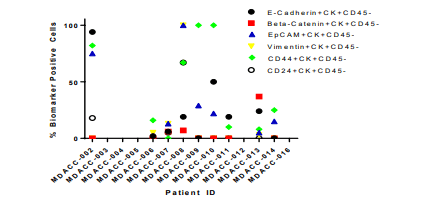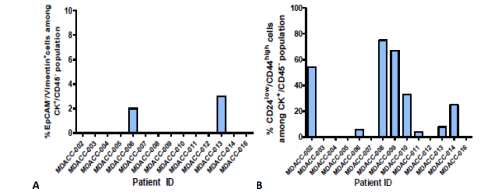Precision for Medicine is part of the Precision Medicine Group, an integrated team of experts that extends Precision for Medicine’s therapeutic development capabilities beyond approval and into launch strategies, marketing communication, and payer insights. As one company, the Precision Medicine Group helps pharmaceutical and life-sciences clients conquer product development and commercialization challenges in a rapidly evolving environment.
- Home
- News & Insights
- Case Studies
- Analysis of Heterogeneity of CTCs Isolated by ApoStream® from Blood of Primary Breast Cancer Patients
Analysis of Heterogeneity of CTCs Isolated by ApoStream® from Blood of Primary Breast Cancer Patients
Clinical Application: Analysis of CTC biology and correlation with patient response rates
Key Words: CTCs, ApoStream®, LSC, epithelial-mesenchymal transition (EMT), cancer stem cells, breast cancer
Background: Detection of CTCs is an indicator of poor prognosis in patients with metastatic breast cancer; however, it has not been linked to prognosis in primary breast cancer patients. Traditional methods for CTC enrichment rely upon the expression of surface antigens, such as epithelial cell adhesion molecule (EpCAM). However, CTC populations are heterogeneous, and some subsets may acquire a more aggressive phenotype with features of invasiveness and motility by undergoing an epithelial to mesenchymal transition (EMT), in the process downregulating EpCAM. EMT is a hallmark of cellular invasion and metastasis, and CTCs undergoing EMT may express the putative cancer stem cell-like (CSC) phenotype, CD24lowCD44+. This study utilizes ApoStream® as a means of analyzing EMT and CSC phenotypes in CTCs isolated from primary breast cancer patients receiving preoperative ystemic therapy in an attempt to correlate the counts of these cell types with the patient’s ability to achieve a pathological clinical response (pCR).
Methods: Baseline blood samples were obtained from 14 newly diagnosed PBC patients prior to receiving preoperative systemic therapy. CTCs were enriched using ApoStream®, and the enriched cells deposited on slides for immunofluorescent staining and analysis. In addition to the markers for the traditional CTC phenotype – cytokeratin, CD45, and DAPI – a multiplexed assay was applied to identify multiple combinations of CTCs (CK+ CD45-) for the expression and distribution of EpCAM, vimentin, CD44, CD24, E-cadherin, and β-catenin. EpCAM and vimentin were multiplexed to examine the EMT phenotype, and CD24 was ultiplexed with CD44 to analyze the CSC phenotype.
Results:
 |
 |
| Figure 1. Biomarker Analysis in CTCs. CTCs (defined as CK+ CD45–DAPI+ cells) were enumerated in multiple tubes from each patient. CTCs were detected in 10 of 14 patients (range = 0 – 165), with the average count per patient ranging from 0 to 91 cells. Expression of each biomarker tested varied; E-cadherin was expressed in 78% of patients, ranging from 2-94% of CTCs; β-catenin was only expressed in 21% of patients, ranging from 6-37% of CTCs. EpCAM, vimentin, CD24 and CD44 expression are analyzed in Figure 2 in greater detail. |
Figure 2. Analysis of EMT and CSC Phenotypes. The CTC population was analyzed for two distinct subtypes: EpCAMVimentin+ , which has been shown to signify the EMT state, and CD24lowCD44+, which represent putative cancer stem cells. Two of 14 patients (14%) were shown to express the EMT-CTC phenotype (Figure 2A), ranging from 2-3% of the CTC population in those patients. Eight of 14 (57%) patients had CTCs expressing the CSC-CTC phenotype, ranging from 8-75% of the CTC population in those patients. |
Impact:
ApoCell has demonstrated that ApoStream® is capable of successfully isolating CTCs of heterogeneous phenotypes from the blood of primary breast cancer patients. Additional testing will examine whether low EMT-CTC and CSCs in baseline blood samples correlates with a higher pCR rate compared to patients with high EMT-CTC and CSC counts.
Reference: Jafferji I, et al. “ApoStream™ Isolated Circulating Tumor Cells from Primary Breast Cancer Patients Reveals Heterogeneous ApoCell, Inc. Phenotypes Related to Epithelial-Mesenchymal Transition and Stem Cell Markers.” NCI-AACR-EORTC 2013.
